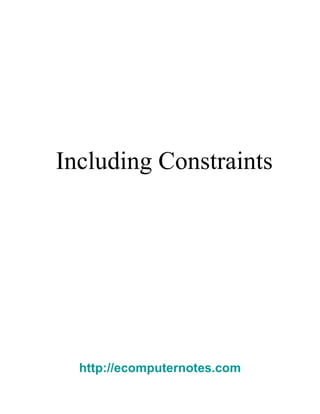
Including Constraints in Oracle Database Tables
- 1. Including Constraints http://ecomputernotes.com
- 2. Objectives After completing this lesson, you should be able to do the following: " Describe constraints " Create and maintain constraints http://ecomputernotes.com
- 3. What are Constraints? " Constraints enforce rules at the table level. " Constraints prevent the deletion of a table if there are dependencies. "T he following constraint types are valid: ± NOT NULL ± UNIQUE ± PRIMARY KEY ± FOREIGN KEY ± CHECK http://ecomputernotes.com
- 4. Constraint Guidelines " Name a constraint or the Oracle server generates a name by using the SYS_C n format. " Create a constraint either: At the same time as the table is created, or After the table has been created " Define a constraint at the column or table level. " View a constraint in the data dictionary. http://ecomputernotes.com
- 5. Defining Constraints CREATE TABLE [ schema .] table ( column datatype [DEFAULT expr ] [ column_constraint ], [ table_constraint ][,...]); CREATE TABLE employees( employee_id NUMBER(6), first_name VARCHAR2(20), job_id VARCHAR2(10) NOT NULL, CONSTRAINT emp_emp_id_pk PRIMARY KEY (EMPLOYEE_ID)) http://ecomputernotes.com
- 6. Defining Constraints " Column constraint level column [CONSTRAINT constraint_name ] constraint_type , " Table constraint level column,... [CONSTRAINT constraint_name ] constraint_type ( column , ...), http://ecomputernotes.com
- 7. The NOT NULL Constraint Ensures that null values are not permitted for the column: « NOT NULL constraint NOT NULL Absence of NOT NULL (No row can contain constraint constraint a null value for (Any row can contain this column.) null for this column.) http://ecomputernotes.com
- 8. The NOT NULL Constraint Is defined at the column level: CREATE TABLE employees( employee_id NUMBER(6), System last_name VARCHAR2(25) NOT NULL, named salary NUMBER(8,2), commission_pct NUMBER(2,2), hire_date DATE User CONSTRAINT emp_hire_date_nn named NOT NULL, http://ecomputernotes.com
- 9. Th e UNIQUE Con st r ain t « Allowed a lready exist http://ecomputernotes.com
- 10. The UNIQUE Constraint Defined at either the table level or the column level: CREATE TABLE employees( employee_id NUMBER(6), last_name VARCHAR2(25) NOT NULL, email VARCHAR2(25), salary NUMBER(8,2), commission_pct NUMBER(2,2), hire_date DATE NOT NULL, CONSTRAINT emp_email_uk UNIQUE(email)); http://ecomputernotes.com
- 11. The PRIMARY KEY Constraint DEPARTMENTS PRIMARY KEY « Not allowed INSERT INTO (Null value) Not allowed (50 already exists) http://ecomputernotes.com
- 12. The PRIMARY KEY Constraint Defined at either the table level or the column level: CREATE TABLE departments( department_id NUMBER(4), department_name VARCHAR2(30) CONSTRAINT dept_name_nn NOT NULL, manager_id NUMBER(6), location_id NUMBER(4), CONSTRAINT dept_id_pk PRIMARY KEY(department_id)); http://ecomputernotes.com
- 13. The FOREIGN KEY Constraint DEPARTMENTS IMARY KEY « MPLOYEE FOREI KEY Not allow INSERT INTO (9 does n exist) Allowed http://ecomputernotes.com
- 14. The FOREIGN KEY Constraint Defined at either the table level or the column level: CREATE TABLE employees( employee_id NUMBER(6), last_name VARCHAR2(25) NOT NULL, email VARCHAR2(25), salary NUMBER(8,2), commission_pct NUMBER(2,2), hire_date DATE NOT NULL, department_id NUMBER(4), CONSTRAINT emp_dept_fk FOREIGN KEY (department_id) REFERENCES departments(department_id), CONSTRAINT emp_email_uk UNIQUE(email));
- 15. FOREIGN KEY Constraint Keywords " FOREIGN KEY : Defines the column in the child table at the table constraint level " REFERENCES : Identifies the table and column in the parent table " ON DELETE CASCADE : Deletes the dependent rows in the child table when a row in the parent table is deleted. " ON DELETE SET NULL: Converts dependent foreign key values to null
- 16. The CHECK Constraint " Defines a condition that each row must satisfy " The following expressions are not allowed: References to CURRVAL , NEXTVAL , LEVEL , and ROWNUM pseudocolumns Calls to SYSDATE, UID, USER, and USERENV functions Queries that refer to other values in other rows ..., salary NUMBER(2) CONSTRAINT emp_salary_min CHECK (salary > 0),...
- 17. Adding a Constraint Syntax Use the ALTER TABLE statement to: "A dd or drop a constraint, but not modify its structure " Enable or disable constraints " Add a NOT NULL constraint by using the MODIFY clause ALTER TABLE table ADD [CONSTRAINT constraint ] type (( column ););
- 18. Adding a Constraint Add a FOREIGN KEY constraint to the EMPLOYEES table indicating that a manager must already exist as a valid employee in the EMPLOYEES table. ALTER TABLE employees ADD CONSTRAINT emp_manager_fk FOREIGN KEY(manager_id) REFERENCES employees(employee_id); Table altered.
- 19. Dropping a Constraint "R emove the manager constraint from the EMPLOYEES table. ALTER TABLE employees DROP CONSTRAINT emp_manager_fk; Table altered. " Remove the PRIMARY KEY constraint on the DEPARTMENTS table and drop the associated FOREIGN KEY constraint on the EMPLOYEES.DEPARTMENT_ID column. ALTER TABLE departments DROP PRIMARY KEY CASCADE; Table altered.
- 20. Disabling Constraints " Execute the DISABLE clause of the ALTER TABLE statement to deactivate an integrity constraint. " Apply the CASCADE option to disable dependent integrity constraints. ALTER TABLE employees DISABLE CONSTRAINT emp_emp_id_pk CASCADE; Table altered.
- 21. Enabling Constraints "A ctivate an integrity constraint currently disabled in the table definition by using the ENABLE clause. ALTER TABLE employees ENABLE CONSTRAINT emp_emp_id_pk; Table altered. "A U NIQUE o r P RIMARY KEY i ndex is automatically created if you enable a UNIQUE key or PRIMARY KEY constraint.
- 22. Cascading Constraints "T he C ASCADE CONSTRAINTS c lause is used along with the DROP COLUMN clause. "T he C ASCADE CONSTRAINTS c lause drops all referential integrity constraints that refer to the primary and unique keys defined on the dropped columns. " The CASCADE CONSTRAINTS clause also drops all multicolumn constraints defined on the dropped columns.
- 23. Cascading Constraints Example: ALTER TABLE test1 DROP (pk) CASCADE CONSTRAINTS; Table altered. ALTER TABLE test1 DROP (pk, fk, col1) CASCADE CONSTRAINTS; Table altered.
- 24. Viewing Constraints Query the USER_CONSTRAINTS table to view all constraint definitions and names. SELECT constraint_name, constraint_type, search_condition FRO M user_constraints WHERE table_name = 'EMPLOYEES'; «
- 25. Viewing the Columns Associated with Constraints View the columns associated with the constraint names in the USER_CONS_COLUMNS view. SELECT constraint_name, column_name FRO M user_cons_columns WHERE table_name = 'EMPLOYEES'; «